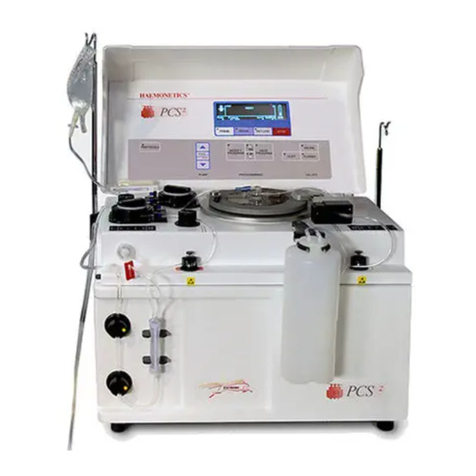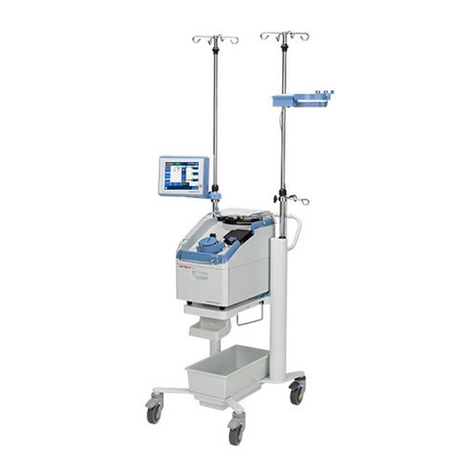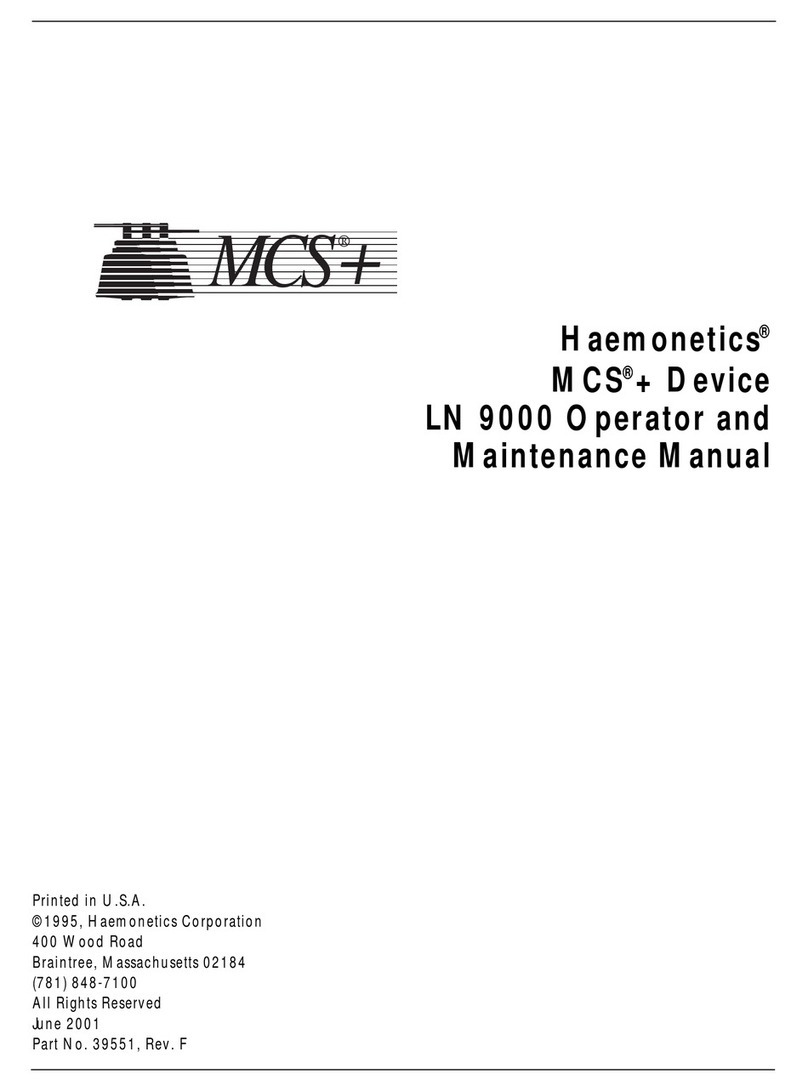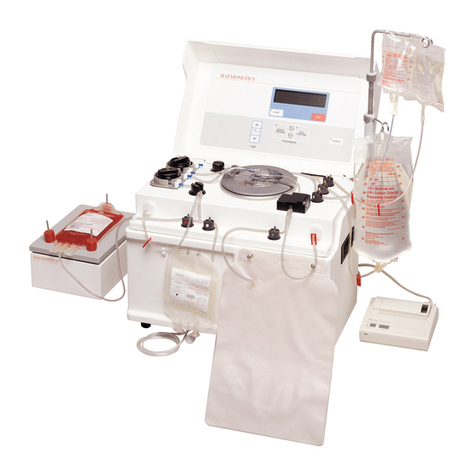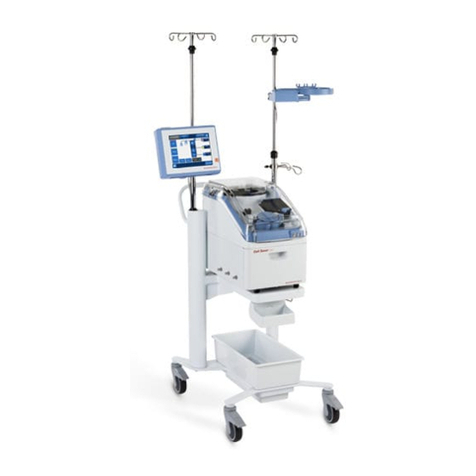
viii Table of Contents
P/N 85266-30, Manual revision: A
DESCRIBING THE PCS2 CONTROL PANEL . . . . . . . . . . . . . . . . . . . . . . . 2-17
Display screen . . . . . . . . . . . . . . . . . . . . . . . . . . . . . . . . . . . . . . . . . . 2-17
Mode control keys . . . . . . . . . . . . . . . . . . . . . . . . . . . . . . . . . . . . . . . 2-19
Protocol key. . . . . . . . . . . . . . . . . . . . . . . . . . . . . . . . . . . . . . . . . . . . 2-19
Pump control keys . . . . . . . . . . . . . . . . . . . . . . . . . . . . . . . . . . . . . . . 2-20
Programming keys . . . . . . . . . . . . . . . . . . . . . . . . . . . . . . . . . . . . . . . 2-20
Cuff key . . . . . . . . . . . . . . . . . . . . . . . . . . . . . . . . . . . . . . . . . . . . . . . 2-21
Valve control keys . . . . . . . . . . . . . . . . . . . . . . . . . . . . . . . . . . . . . . . 2-21
Chapter 3 Maintaining the PCS2 Equipment
CLEANING PROCEDURES . . . . . . . . . . . . . . . . . . . . . . . . . . . . . . . . . . . . . 3-2
Cabinet, control panel and valves . . . . . . . . . . . . . . . . . . . . . . . . . . . . 3-2
Pressure monitors. . . . . . . . . . . . . . . . . . . . . . . . . . . . . . . . . . . . . . . . . 3-3
Air detectors . . . . . . . . . . . . . . . . . . . . . . . . . . . . . . . . . . . . . . . . . . . . 3-3
Optical sensors . . . . . . . . . . . . . . . . . . . . . . . . . . . . . . . . . . . . . . . . . . 3-3
Fluid detector. . . . . . . . . . . . . . . . . . . . . . . . . . . . . . . . . . . . . . . . . . . . 3-4
Centrifuge components . . . . . . . . . . . . . . . . . . . . . . . . . . . . . . . . . . . . 3-4
Pumps . . . . . . . . . . . . . . . . . . . . . . . . . . . . . . . . . . . . . . . . . . . . . . . . . 3-5
Filter screens . . . . . . . . . . . . . . . . . . . . . . . . . . . . . . . . . . . . . . . . . . . . 3-5
Barcode reader. . . . . . . . . . . . . . . . . . . . . . . . . . . . . . . . . . . . . . . . . . . 3-5
CUSTOMER SERVICE . . . . . . . . . . . . . . . . . . . . . . . . . . . . . . . . . . . . . . . . . 3-6
Clinical training . . . . . . . . . . . . . . . . . . . . . . . . . . . . . . . . . . . . . . . . . . 3-6
Field service. . . . . . . . . . . . . . . . . . . . . . . . . . . . . . . . . . . . . . . . . . . . . 3-6
Returned Goods Authorization system . . . . . . . . . . . . . . . . . . . . . . . . . 3-6
HAEMONETICS®CLEANING AND MAINTENANCE RECORD . . . . . . . . . 3-8
Chapter 4 Ensuring Safety and Quality for a PCS2 Procedure
HANDLING THE PCS2 EQUIPMENT . . . . . . . . . . . . . . . . . . . . . . . . . . . . . 4-2
Storing the PCS2 device and material. . . . . . . . . . . . . . . . . . . . . . . . . . 4-2
Inspecting the material. . . . . . . . . . . . . . . . . . . . . . . . . . . . . . . . . . . . . 4-2
PREVENTING PROBLEMS DURING A PCS2 PROCEDURE. . . . . . . . . . . . . 4-3
Understanding the risk of hemolysis. . . . . . . . . . . . . . . . . . . . . . . . . . . 4-3
Avoiding the consequences of flow restriction . . . . . . . . . . . . . . . . . . . 4-3
Avoiding bowl misalignment . . . . . . . . . . . . . . . . . . . . . . . . . . . . . . . . 4-4
Avoiding overheating due to mechanical situations . . . . . . . . . . . . . . . 4-4
Controlling for Red Cell Overrun . . . . . . . . . . . . . . . . . . . . . . . . . . . . . 4-4
WARNINGS FOR THE OPERATOR. . . . . . . . . . . . . . . . . . . . . . . . . . . . . . . 4-5
Electrical shock hazards . . . . . . . . . . . . . . . . . . . . . . . . . . . . . . . . . . . . 4-5
Leakage current control . . . . . . . . . . . . . . . . . . . . . . . . . . . . . . . . . . . 4-5
Mechanical hazards/rotating parts . . . . . . . . . . . . . . . . . . . . . . . . . . . . 4-5
Power outlet connection . . . . . . . . . . . . . . . . . . . . . . . . . . . . . . . . . . . 4-5
Communicable disease precautions . . . . . . . . . . . . . . . . . . . . . . . . . . . 4-6






